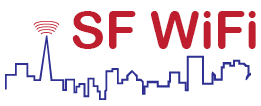The IEEE 802 standards organization has officially ratified 802.11n. The high speed 802.11n Wi-Fi standard has been in draft status for nearly two years as engineers worked out their differences. As an official standard, 802.11n certified devices should work together, even from different vendors. Officials plan to publish the final standard in mid-October.IEEE standardization will ensure interoperability and high speed. It will theoretically connect at 300Mbps, about six times the theoretical 54 Mbps peak speed of the previous 208.11g/a standards. Typical thoughput of “N” is expected to be around 144 Mbit/s.
Monthly Archives: September 2009
Working hard theme song
Did you ever get engrossed in a project and you keep getting phone calls with people that want to chit chat. Ugh! “I’ve got work to do”.
Theme song: Little Village – Dont bug me when I’m working:
SF WiFi – Monster Home Wireless
SF WiFi serves customers in the Hospitality, SMB and Hotspots market – but what home wireless solutions? We do support the home wireless market and we have worked for home clients where the SOHO wireless equipment couldn’t get the job done. We refer to these projects as “Monster Home” projects.

iPhone – Bandwidth Hog
iPhone Bandwidth Hog – (“Jump on a wireless connection” – SF WiFi)
While AT&T and Apple have remained silent on the absence of tethering and MMS with the iPhone, a new report provides insight on the effect an influx of bandwidth-heavy mobile users have had on the wireless network.
Digging into customer dissatisfaction with the AT&T network, The New York Times revealed that the carrier has struggled to keep up with demand as iPhone owners use more and more bandwidth. The report suggests that AT&T’s reputation could be tarnished because, for some users, its network is unable to keep up with demand. The bandwidth issues have led to delays of tethering and multimedia messaging, much-anticipated features for iPhone users.
“The result is dropped calls, spotty service, delayed text and voice messages and glacial download speeds as AT&T’s cellular network strains to meet the demand,” the report, which compared the device to a gas-guzzling Hummer, states. “Another result is outraged customers.”
The average iPhone user reportedly consumes 10 times the bandwidth of a typical smartphone user, but that is expected to change in the near future. The growth of the iPhone and its impact on the AT&T network has even led to lawsuits. As other mobile devices emulate the iPhone and also use more network capacity, the problem is expected to grow on all networks, not just AT&T.
Even John Donovan, chief technology officer for AT&T, admitted his company’s struggles. “It’s been a challenging year for us,” he told the Times.
But in the face of demand, AT&T plans to spend $18 billion this year to upgrade and expand its 3G network. And the company has no plans to cap data use, whether solely through the phone or via tethering with a computer.
AT&T announced Wednesday that it had improved its 3G coverage in metro New York and New Jersey. The company expects to roll out nationwide improvements with HSPA 7.2 technology, with the upgrade to be completed in 2011. And 1,900 new cell towers are planned for construction in the U.S. this year as well. But expansion isn’t so simple.
“As fast as AT&T wants to go, many cities require lengthy filing processes to erect new cell towers,” the report states. “Even after towers are installed, it can take several months for software upgrades to begin operating at faster speeds.”
Many analysts believe that when Apple’s exclusive contract with AT&T expires in 2010, the handset maker will offer the iPhone on other carriers. The most obvious jump would be to Verizon, the largest carrier in the U.S., ahead of No. 2 AT&T.
Fromt the Apple Insider
http://www.appleinsider.com/articles/09/09/03/bandwidth_guzzling_iphone_called_hummer_of_cellphones.html
